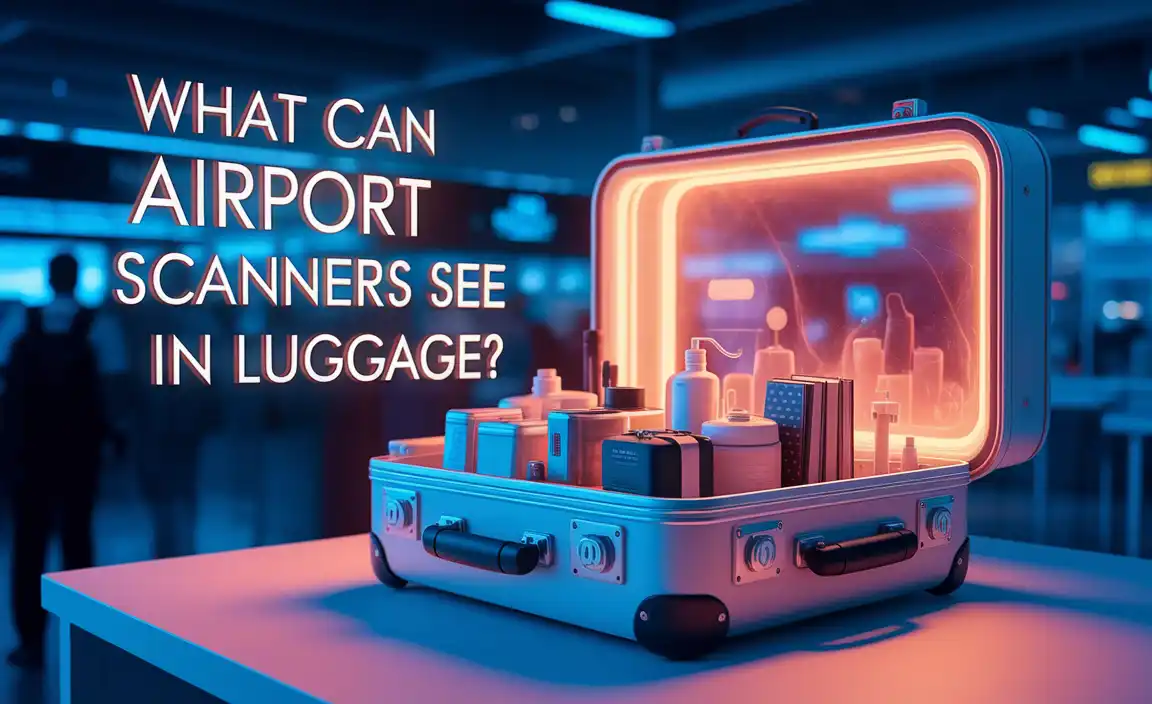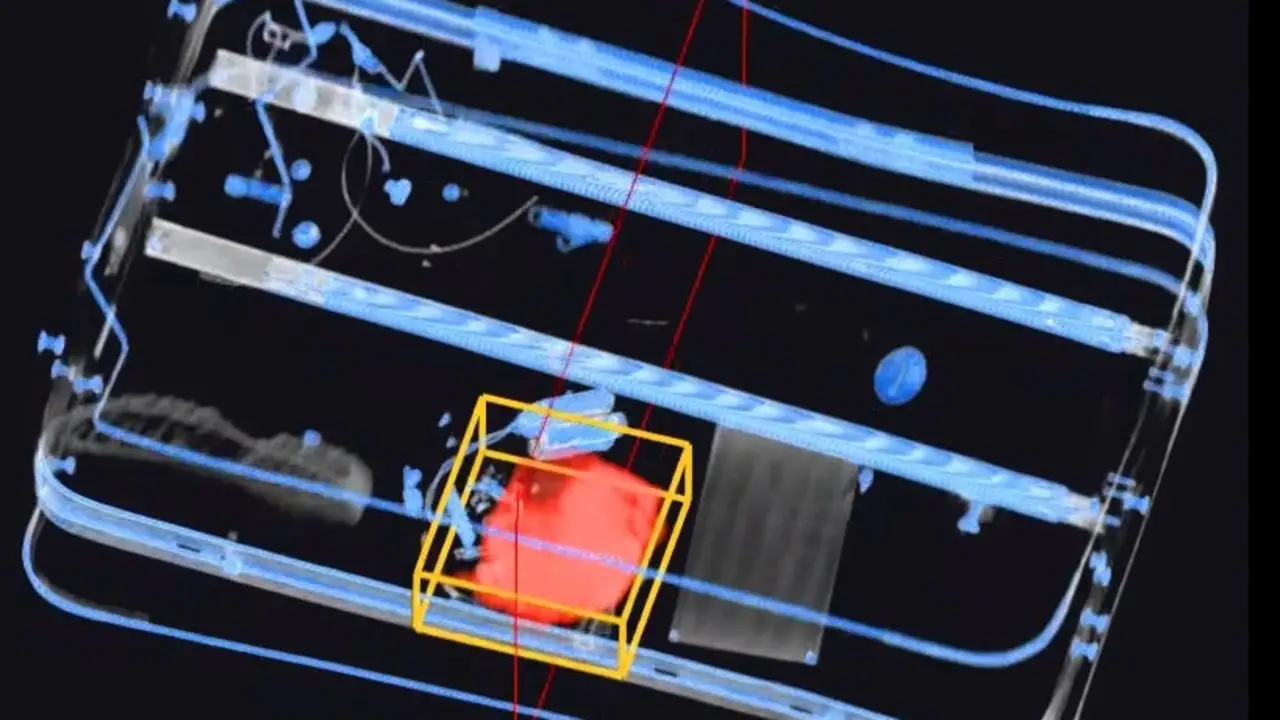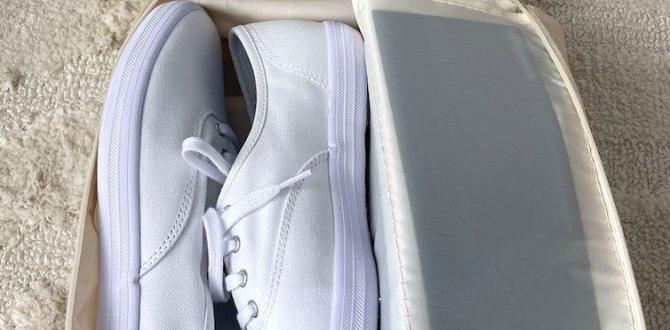Airport scanning technology refers to the different types of scanners used at airports to screen luggage and passengers. These include X-ray, millimeter-wave, and explosive trace detection (ETD) scanners.
X-ray scanners can detect potential security threats by seeing through luggage, while millimeter-wave scanners create 3D images of a person’s body to detect concealed items. Here we will delve into the world of airport scanners and explore what can airport scanners see in luggage.
From X-ray machines to millimeter-wave scanners, we’ll break down the technology behind these devices and give you a better understanding of what happens when your bag goes through that conveyor belt. So if you’ve ever been curious about the inner workings of airport security, keep reading to find out what those scanners can detect.

What Can Airport Scanners See In Luggage – You Should Know
Understanding what airport scanners can see in luggage is essential for several reasons. It helps alleviate concerns and anxiety while traveling by providing a clearer picture of the security screening process.
Additionally, knowing what items are detectable by airport scanners enables travelers to pack their bags more efficiently, reducing the likelihood of potential delays or confiscations at security checkpoints. Here we are going to discuss what can airport scanners see in luggage to enhance your travel knowledge.
Detection Of Liquids And Powders
Airport scanners have the ability to detect liquids and powders within luggage. Powders, such as baby powder or protein powder, may undergo additional screening if they exceed certain quantities. Scanners utilize. People restrict liquids to containers no larger than 3.4 ounces (100 milliliters).
They must be placed in a clear, quart-sized plastic bagX-ray technology to create images of luggage contents, allowing security personnel to identify potential threats. It is crucial to adhere to the rules and regulations concerning liquids and powders when packing your luggage to avoid any potential delays or confiscations at the airport.
Identifying Electronic Devices And Batteries
Airport scanners have the ability to detect electronic devices and batteries in luggage. This includes items like laptops, tablets, smartphones, and power banks. The scanners can analyze the shape and density of these items, but they cannot access the specific content stored on electronic devices.
To ensure compliance with airport regulations, following guidelines regarding placing electronic devices in carry-on or checked luggage is important. However, if you have any concerns about your devices or batteries being scanned, you can always request a manual inspection by security personnel.
Spotting Sharp Objects And Weapons
Airport Scanners Utilize X-Ray Technology To Peer Into Luggage, Efficiently Identifying Potential Threats. These scanners can detect a wide range of items, including metal objects like knives and guns. In addition to metal, they can also identify sharp objects such as blades or scissors.
Furthermore, these advanced scanners have the ability to detect organic materials like explosives or drugs, ensuring that prohibited items do not make their way onto flights. Airport scanners play a crucial role in maintaining air travel security by prioritising passenger safety.
Recognition Of Organic Materials
Airport scanners have the ability to detect various types of organic materials in luggage. These materials include food, plants, and liquids. Additionally, they can identify prohibited items such as weapons, explosives, and drugs. People use X-ray scanners to see through luggage and determine its contents.
Advanced imaging technology (AIT) scanners utilize millimeter-wave technology to create detailed images of scanned objects. Some scanners can even detect trace amounts of chemicals or substances used in illegal activities. However, it’s important to note that airport scanners cannot see through metal or dense materials, which means items hidden inside these materials may not be detected.
Differences Between Carry-On And Checked Bag Scans
Carry-on luggage scans utilize airport scanners to detect potential threats, including weapons, explosives, and liquids exceeding the allowed limit. On the other hand, checked bag scans are more powerful and can identify a wider variety of items, including drugs and other illegal substances.
While airport scanners have privacy concerns, advanced imaging technology blurs the scanned images to protect passengers’ privacy. Both carry-on and checked bag scans emit low levels of radiation that are considered safe for passengers regarding radiation levels. Additionally, random screening can subject passengers to additional checks, regardless of the scan results.
The Level Of Detail Seen In Carry-On Bag Scans
Carry-on bag scans reveal a higher detail level than checked bag scans. Using X-ray technology, airport scanners can detect items such as liquids, gels, metals, and electronics in carry-on luggage.
These scans create detailed images of the bag, allowing security personnel to identify potential threats or prohibited items. To ensure a smooth security screening process at airports, it is important for travelers to follow TSA guidelines and regulations.
What Is Visible In Checked Bag Scans

Checked bag scans utilize more powerful X-ray technology compared to carry-on bag scans. This advanced scanning capability allows airport scanners to see through various materials, including clothing, plastic, and paper. This enables them to detect weapons, explosives, and illegal substances.
However, it’s important to note that airport scanners cannot see inside metal containers or dense objects. Developers have created new scanning technologies that can blur or mask specific areas of scanned images to address privacy concerns.
Can Airport Scanners Detect Illegal Substances?
Airport scanners have the capability to detect certain illegal substances, including drugs and explosives. These scanners can use advanced imaging technology to identify organic and inorganic materials in luggage. However, we must note that airport scanners cannot specifically detect every type of illegal substance. When suspicious items are detected, you may need further inspection or testing.
The Capability Of Scanners To Detect Drugs
Airport scanners utilize advanced technologies, including X-rays and millimeter-wave imaging, to scan luggage during security screening. These scanners can detect various items, such as weapons, explosives, and drugs.
However, it’s important to note that airport scanners primarily focus on identifying potential threats to security rather than specifically targeting illegal substances. Scanners can detect organic materials like drugs, but they are not designed to differentiate between different types of substances. Airport security personnel may investigate further if they detect a suspicious item during the scanning process.
Other Prohibited Items That Can Be Detected
Airport scanners can detect a wide range of items in luggage, including weapons, explosives, and illegal substances. Advanced imaging technology scanners create detailed luggage images, allowing security personnel to identify prohibited items. X-ray scanners can also detect organic materials, such as drugs or food items, which may be hidden in luggage.
Additionally, airport scanners can detect prohibited items like liquids over the allowed limit, sharp objects, and flammable materials. Travelers should familiarize themselves with the list of prohibited items to avoid issues at security checkpoints.
Full-Body Scanners At Airport Security
Full-body scanners play a crucial role in airport security by detecting potential threats concealed on a person’s body. These scanners utilize either millimeter-wave technology or backscatter X-ray technology to generate a detailed image of the individual’s body. Full-body scanners enhance the effectiveness of security screening with their capability to identify both metallic and non-metallic items, including weapons, explosives, and drugs
. Despite privacy concerns, measures are in place to safeguard passengers’ privacy during the scanning process. By ensuring passenger safety and enabling thorough security checks, full-body scanners contribute significantly to airport security.
What Full-Body Scanners Can See
The designers have created the full-body scanners at airport security to detect potential threats or prohibited items on a passenger’s body or in their clothing. These scanners use millimeter wave or backscatter technology to create an image of the person’s body without revealing explicit details.
Millimeter wave scanners use radio waves to create a three-dimensional image, highlighting concealed objects. Backscatter scanners use low-energy X-rays to create a two-dimensional image, showing objects hidden under clothing.
Trained security personnel view the images to identify suspicious or dangerous items. Airport scanners can detect weapons, explosives, drugs, and other prohibited items but cannot see through solid objects like metal.
Health And Privacy Concerns Related To Full-Body Scans
Full-body scanners at airports use either millimeter-wave technology or backscatter X-ray technology to create an image of a person’s body. Millimeter-wave scanners consider non-ionizing radiation safe for passengers.
Backscatter X-ray scanners use low levels of ionizing radiation, but the dose is extremely small and poses no health risk.Due to the detailed images created by full-body scans, people have raised privacy concerns. To address these concerns, the Transportation Security Administration (TSA) has implemented privacy filters that blur sensitive areas in the image.
The Future Of Airport Scanning Technology
Emerging technologies are shaping the future of airport scanning. Current airport scanning technology already allows for detecting a wide range of items in luggage. However, advancements such as millimeter-wave scanners and advanced imaging technology are pushing the boundaries further. These technologies offer enhanced capabilities and improved accuracy in identifying potential threats.
Privacy concerns related to airport scanning are also being addressed, with measures like privacy filters implemented. Looking ahead, the future of airport scanning technology holds exciting possibilities, including integrating artificial intelligence and machine learning to improve security processes.
Emerging Technologies In Airport Security
Airport scanners continually improve to enhance security measures and detect prohibited items. Advanced Imaging Technology (AIT) scanners are an emerging technology that can produce detailed images of luggage contents, including clothing, personal belongings, and electronic devices.
These scanners utilize either millimeter-wave technology or backscatter X-ray technology to create images. Millimeter-wave scanners use non-ionizing radiation, providing a general body outline and concealed objects without revealing anatomical details.
Backscatter X-ray scanners emit low levels of ionizing radiation and offer more detailed images of the body and its contents. The Transportation Security Administration (TSA) has implemented privacy safeguards like automated target recognition software to protect passenger privacy during scanning.
Conclusion
Airport scanners play a crucial role in ensuring the safety and security of air travel. These advanced scanning technologies can detect a wide range of items and substances that may threaten passengers and aircraft. While the exact capabilities of airport scanners may vary, they can typically identify metallic objects, organic materials, liquids, and certain types of powders.
This allows security personnel to identify potential threats and take appropriate action quickly. Travelers should know what can be seen in luggage to ensure compliance with regulations and help facilitate a smooth screening process. By understanding the what can airport scanners see in luggage, passengers can ensure a safe and efficient journey through the airport.
Frequently Asked Questions
[rank_math_rich_snippet id=”s-a596129d-637a-44f5-adae-7404fb439579″]


![Put Back In Adult Diapers Full Time [Wear Diaper As An Adult]](https://logds.com/wp-content/uploads/2023/03/Put-Back-In-Adult-Diapers-Full-Time-Wear-Diaper-As-An-Adult.webp)




